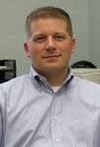CBE Seminar: Single Molecule Investigations of Heterogeneous Catalysts: Probing Solvent Effects, Active Site Heterogeneity and Adsorbate Dynamics

Dr. Robert Rioux
Abstract:
Metal nanoparticles are key components in the advancement of future energy technologies since they are catalytically active for several organic-inorganic syntheses, electron-transfer, and energy conversion reactions. They directly promote chemical conversion and/or facilitate chemical transport to active interfaces. A detailed understanding of the relation between structure and the properties of nanoparticles will lead to tailored catalytic properties. Although these structure-function relationships are pursued by many researchers; they are typically limited to ensemble-level approaches where the intrinsic catalytic behavior of individuals is masked due to the asynchronicity in real-time of their behaviors during catalytic turnover. We employ a single molecule approach utilizing a two-state (pro-fluorescent to fluorescent) reduction reaction to examine the catalytic behavior of individual Au nanoparticles with single turnover resolution. Through kinetic modeling and isotopic labeling of solvent, we demonstrate competitive binding between solvent and substrate accounts for differences in observed catalytic rates at the ensemble level. Temperature-dependent measurements of the catalytic activity of single nanoparticles reveals heterogeneity in reactivity and kinetic parameters which are due to static dispersion even though the dispersion varies temporally; these variations are ascribed to the intrinsic reactivity of populations of indistinguishable active sites. Approaches to selectively titrate distinct active site populations on the surface of individual Au nanoparticles have enabled us to distinguish between their intrinsic kinetic behavior and utilizing ideal models of nanoparticle structure confirm their identity and concentration. The ability to probe reaction dynamics during single molecule catalytic turnover utilizing an experimental and theoretical approach to understand delayed rise times in fluorescent response will be discussed time permitting.
Biography:
Robert (Rob) M Rioux is the Friedrich G. Helfferich Assistant Professor of Chemical Engineering at the Pennsylvania State University. Prior to joining the Pennsylvania State University in 2008, he was a National Institutes of Health Postdoctoral Fellow at Harvard University in the Department of Chemistry and Chemical Biology working with Professor George Whitesides. He received his Ph.D. in physical chemistry from the University of California, Berkeley in 2006 working for Professor Gabor Somorjai. He holds a B.S. and M.S. degree in chemical engineering from Worcester Polytechnic Institute and the Pennsylvania State University, respectively. Since joining the Penn. State faculty, he has received a number of awards, including a DARPA Young Faculty Award, an Air Force Office of Scientific Research Young Investigator Program Award, a NSF CAREER Award and a 3M Non-Tenured Faculty Award. Research in his laboratory is currently sponsored by NSF, DOE-BES, DARPA, AFOSR, AFRL, ACS-PRF and industry. His group’s current research focus is on the development of spatially- and temporally-resolved spectroscopic techniques for imaging catalytic chemistry, single molecule methods to understand single molecule/particle catalytic kinetics and dynamics, elucidating reaction mechanisms in nanoscale systems, including catalyst synthesis, development of solution calorimetric techniques to understand catalytic processes at the solid-liquid interface and the development of base-metal catalysts for chemoselective chemical transformations, including biomass to chemicals conversion.
Please view the Dr. Robert Rioux flyer for more information.
This seminar is sponsored by the Department of Chemical and Biomolecular Engineering.